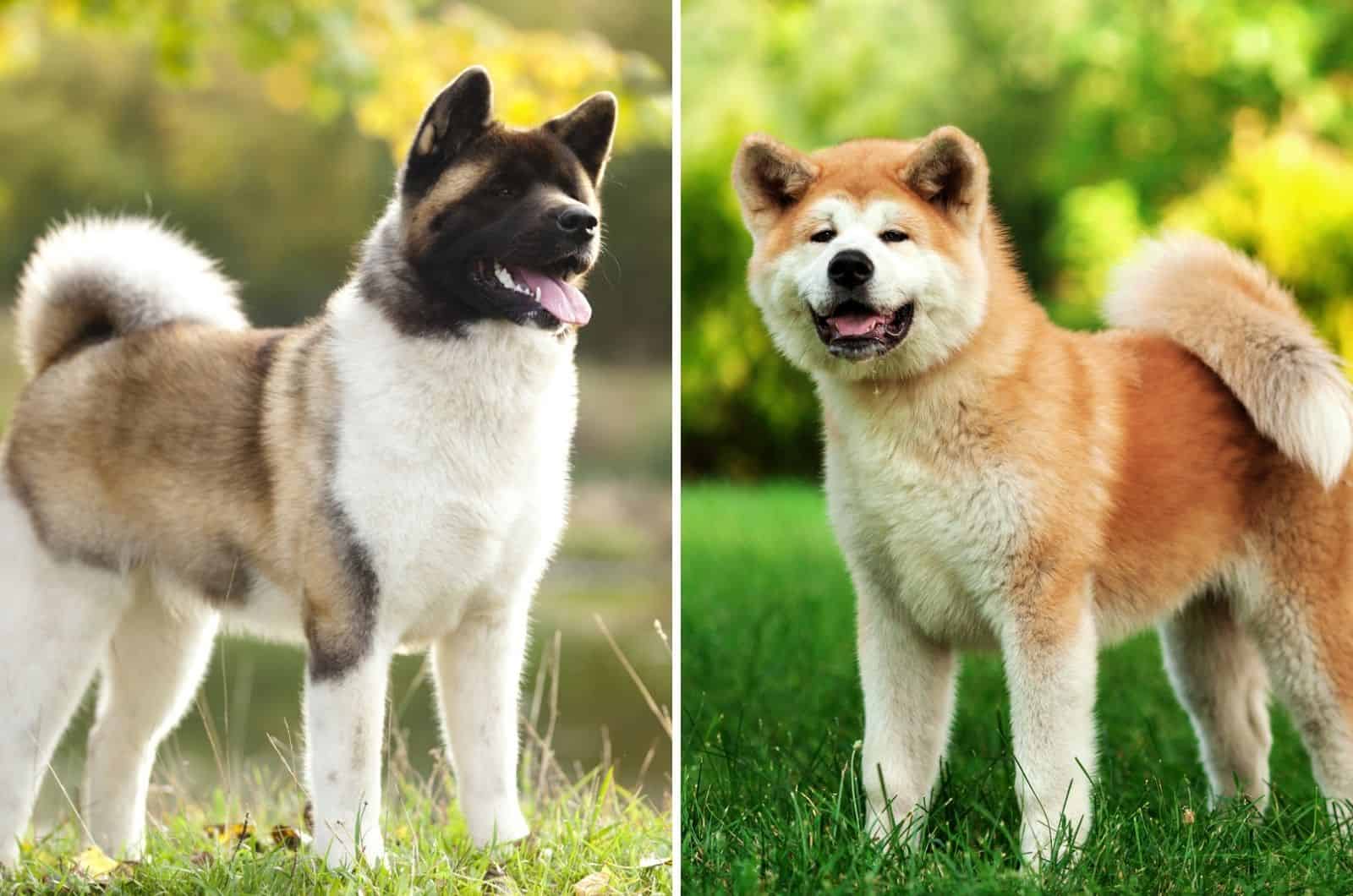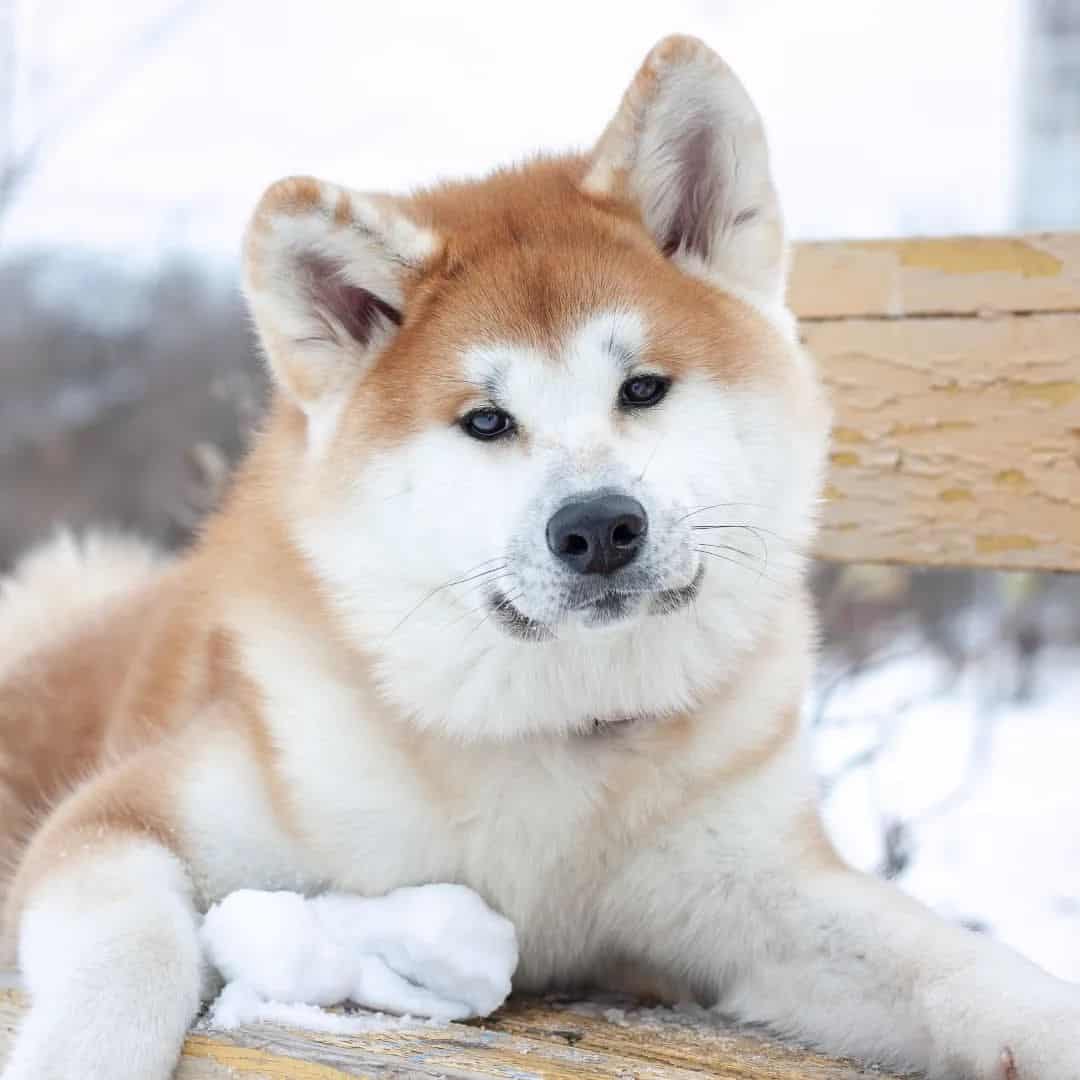Lots of people instantly recognize the Akita dog when they see one.
Over the centuries, the Akita have won the hearts of millions, making the leap across the Pacific Ocean and changing in the process.
But, wait… how are these two different breeds?
It’s like the Husky and the Malamute, right?
If you are not acquainted with this large dog breed, you might be confused. We often just bunch them together.
And, no… we’re not talking about the Shiba Inu.
You might even be a fan of this goofy-looking dog breed without knowing it.
The trademark appearance of this large breed will likely pop into your head immediately. Whether you are well versed in cynology or not, you probably know what an Akita looks like.
The Japanese Akita Inu grew to become a true citizen of the world, loved and celebrated across the globe.
Don’t let their goofy and aloof appearance fool you – these dogs are nothing to toy with!
The Akita is an ancient breed bearing a strong genetic connection to wolves, while some would even say that Akita looks like she is related to bears!
This dog is known to be very tough, hard to manage, and especially wary of strangers.
However, their unwavering loyalty and urge to protect is what singles them out as such an iconic dog that millions all over the world revere.
This is especially true in its native Japan, where the Akita holds the status of the national dog, and is for many, synonymous with Japan and its history and culture as well as the spirit of Bushido.
However, throughout history’s twists and turns, this iconic dog breed split into two different breeds, recognized to be separate by kennels worldwide and bred as such: the American Akita and the Japanese Akita, also known as the Akita Inu (Inu meaning ‘dog’ in Japanese).
This is a story of Japan, America, curled tails, bloodlines, a world war and, uh… Helen Keller?
We will discuss it in today’s topic: the American Akita vs. the Japanese Akita: What’s the difference, what do they have in common, and which one suits you better?
Let’s find out!
The Difference Between The American / Japanese Akita Is Obvious!
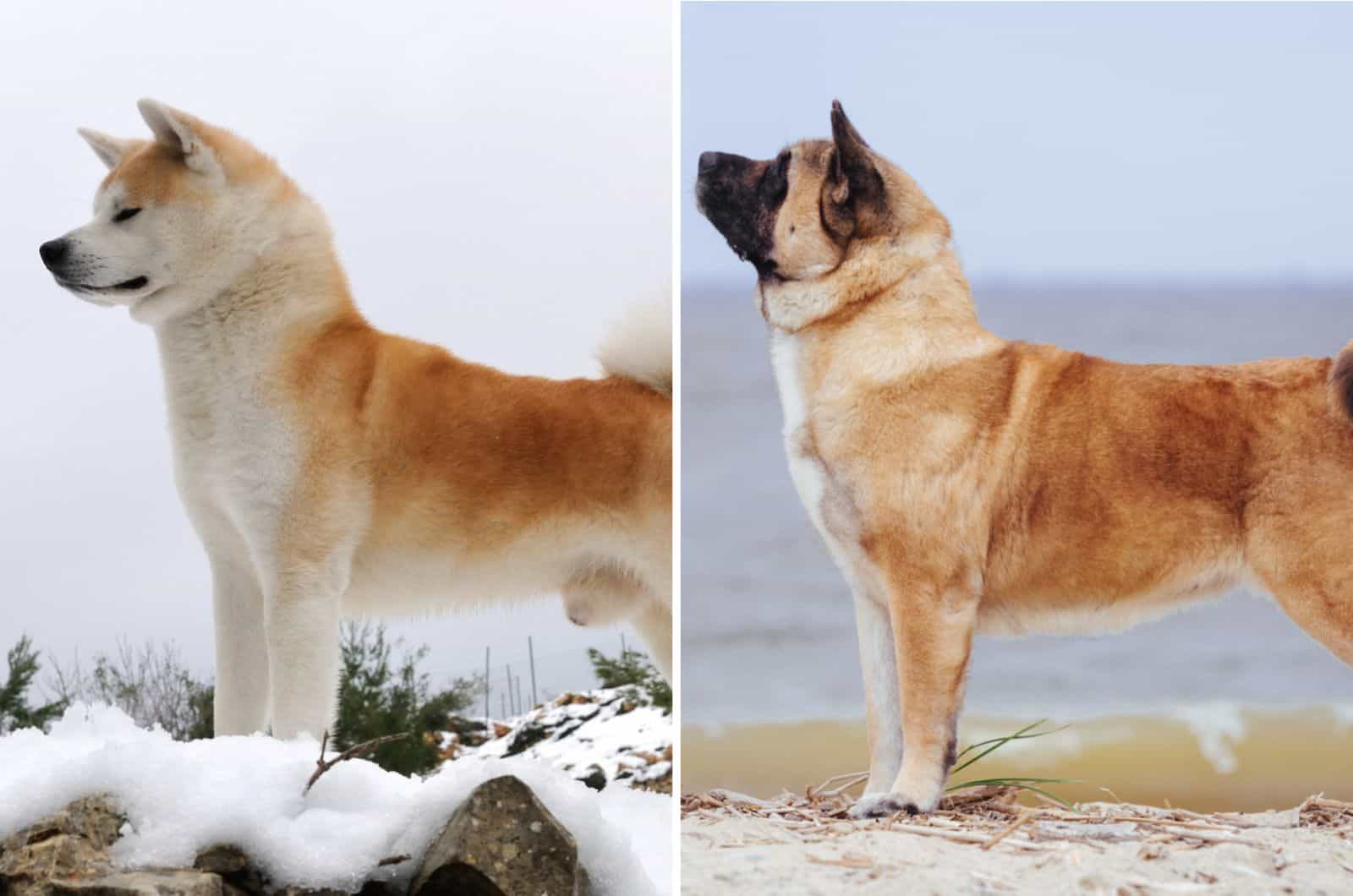
Roughly put, their difference lies in their size, frame. and coat color/pattern, but a lot of other breeds have this, and aren’t considered as separate by kennel clubs…
This is not true in Akita Clubs, where breeders have a strict definition of what makes either of these dogs unique, and for good reason!
Despite having different and well-defined breed standards, they both share the same ancestry, and they have a lot in common like all family members do.
Some of those things are the Akita’s ears and curled tail, which are recognizable as a fault.
So, why is the Akita breed so distinct?
Well, to answer that, we have to dive into some historical as well as biology facts.
First, we should be able to tell one from the other.
What Does The Japanese Akita Look Like?
Photo from: @irochka196
You’ll know one when you see one.
Like a… Like a goofy, yellow wolf?
This moderately large dog belongs to the group of spitz breeds, all of which share some attributes and bear some resemblance to wild canids, such as the wolf or the fox.
The Akita’s ears are delightfully pointy and furry, and its trademark tail is perfectly curled along the slope of its back.
Its build is very powerful, yet slender. It has small, beady, slightly slanted eyes, and due to its large, stretchy cheeks, its mouth often resembles a soft, nervous smile.
Its coat is built to withstand extremely cold mountainous weather, and it is blessed (and its owner cursed) with a thick, luxurious double coat to keep the chilly winds at bay and protect it from bites and injuries.
The original Japanese breed only comes in a few colors, but more on that later!
What Does The American Akita Look Like?
When you get to know them, the difference is very easy to distinguish.
The American Akita is mixed with some European breeds, and it carries a vague resemblance to its western parent breeds, but takes much more after the Akita Inu.
Your first clue should be fur color. The American Akita isn’t bothered by tradition, and it comes in a variety of different colors and patterns.
Because of their ‘western’ admixture, their head became wider and more robust, losing some of its foxy spitz sharpness.
Their face is much less droopy, and it looks more like that of the German Shepherd, giving it a different expression by which it is easily distinguishable. It is also common for the American Akita to have a black mask.
Their paws are massive and look like bear paws. They are powerful runners, full of lean muscle.
Their pointy ears and forward-curled tail are something that hasn’t changed, so it’s safe to assume that early Akita breeders found them as charming as we do.
What Are American Akitas Mixed With?
It’s obvious at first glance that there’s something in the American strain that bears resemblance to the German Shepherd, the Saint Bernard, or even the Rottweiler. The breed is standardized by the American Kennel Club (AKC) in terms of desirable traits, and it looks uniform enough, but what really reveals its large gene pool is the wide array of colors the breed displays.
So, what’s different about the two breed standards? Let’s examine what sets apart the American and the Japanese Akita Inu by using a series of comparisons.
Japanese Akita vs. American Akita: Coat Color Patterns
Traditional Akita Inus are most often red or fawn, but they are also brindle as well as pure white.
Also, a hallmark of the breed is the Urajiro color pattern; whitish markings on parts of its body, which is something it shares with its cousin, the Shiba Inu.
The Akita dog has a long and short coat variant, but it is stressed by Akita clubs that the coat should be of the shorter type.
You can see in the AKC breed standards that the American Akita comes in almost all colors known to man and dog alike.
The most commonly seen ones are pinto, white, brindle, etc., and they are often seen sporting a black mask as opposed to the Japanese dog.
They often have strange ‘tiger stripe’ patterns stemming from their undercoat.
It’s very easy to tell them apart despite their common ancestry.
American vs. Japanese Akita – Which Is Bigger?
According to the Akita growth chart, the American Akita’s standard height is around 28 inches at the shoulder for males, and 26 inches for females. This is average, which is also the upper end of the measurements of its original breed.
The thing that makes it appear a lot bigger is its robust and muscular build.
This is a very bear-like and powerful dog, and the Japanese Akita seems gentle in comparison. Its big, heavy paws look like they belong on a mountain lion.
It also has somewhat thicker fur and a great big head and mighty maw, even compared to the rest of its sizable body.
All in all, the American dog is much more robust than the Japanese dog.
Japanese Akita Vs. American Akita – Temperament
The Akita seems like a very calm and composed dog, but it is often anything but, and potential owners need to be cautious of what lurks behind the facade of its calm demeanor.
It is a very loyal breed, and it gets very protective of its owner, especially around strangers.
If German Shepherd blood means anything, then the American Akita could be the more obedient and fast-learning of the two. It is for this purpose that they were interbred in World War II.
This dog is also very, very powerful and hard to handle, and it needs to be socialized from a young age, taught not to jump on people, get along with other dogs, etc.
The same goes for the former.
They tend to be more energetic than the aloof, seemingly disinterested Japanese breed.
Akita have often been compared to cats because of both their temperament and apparent cleanliness. Akita tend to groom themselves, unlike most dogs.
They were bred to hunt wild boar and have a strong prey drive.
As a spitz breed, it is closer to the wolf than most dogs, and as such, it is comparable to the Husky in terms of behavior tendencies.
American vs. Japanese Akita: History Made Way For The Akita Split
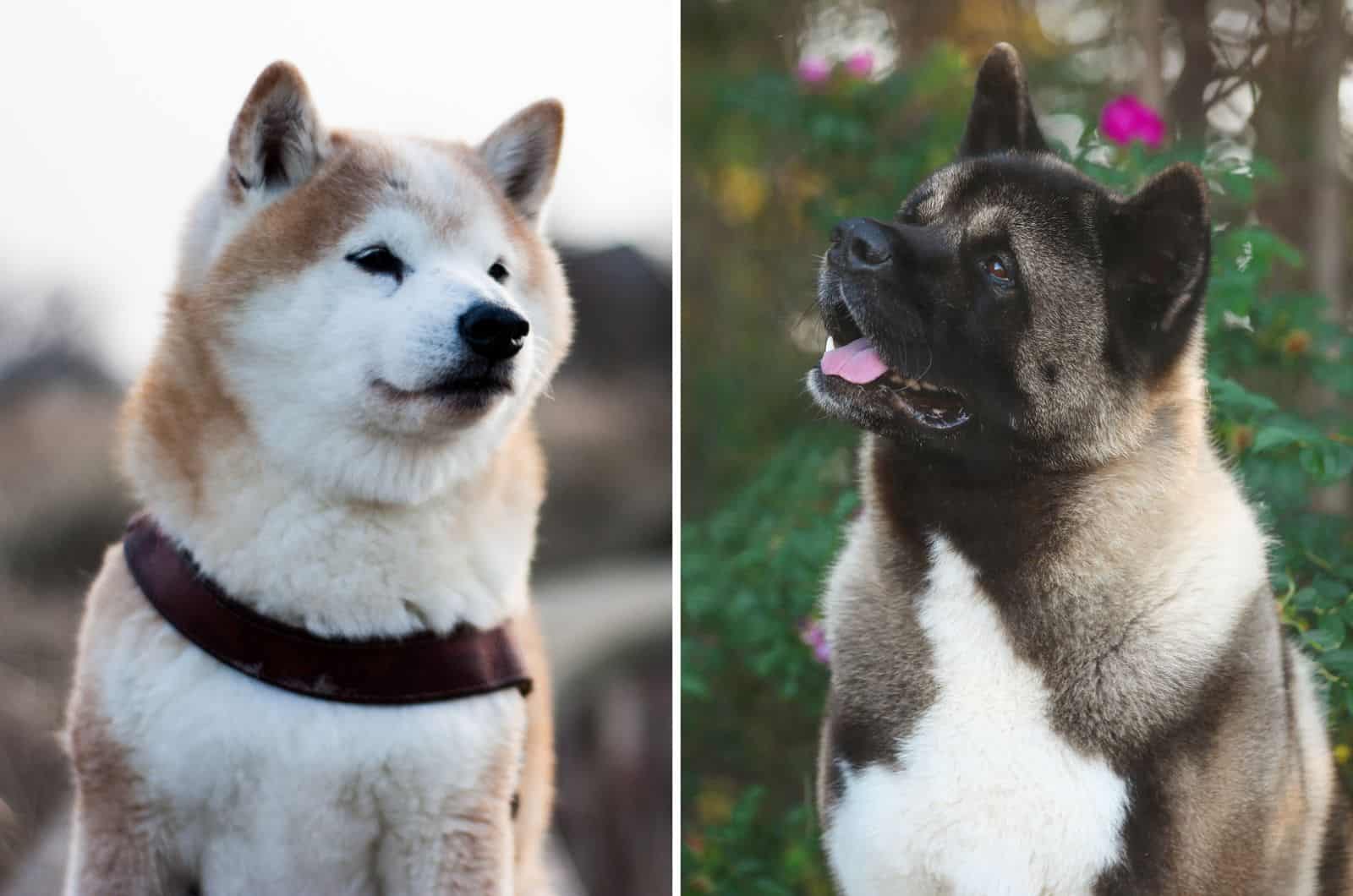
It’s one thing to mix two dogs, but a whole separate breed? And, still with the same name?
It’s very unusual indeed. But, it will be a bit clearer once you get to know the history of the pair, which is closely knit with the history of its two progenitor nations.
The Japanese Akita Is A Living Monument To Japan…
The Japanese adore this prudent, loyal, charming, and useful breed of dog. It is, in a way, considered as a symbol of everything traditional Japanese morality stands for.
This is, in part, because of the popularity of the story of Hachiko, the world’s most famous Akita.
Akita were declared living monuments by the Japanese government in the early 20th century, and as such, they took on a unique role in history beyond any hunting dog or guard dog titles they had previously held.
…The Akita Came From North Japan And Spread Quickly
It is believed that the Akita Inu first originated in the mountainous regions north of the island of Honshu, Japan, in the eponymous Akita prefecture and its capital of Ōdate.
Akita were, at first, used as hunting dogs to hunt large game, ranging from small game to wild boar to even brown bears.
Anecdotal accounts and folk stories have them acting as companions to samurai during and after the age of war in Japan, the Sengoku Jidai, and throughout the remainder of the samurai age.
Centuries went by and a lot of things came to pass.
As Japan changed, so did the Akita dog.
So, How Is It Possible That The Japanese Akita Almost Went Extinct?
In the early 20th century, up until then, a traditionally closed and off-limits country, Japan started slowly opening up to foreign influence.
As Western culture, its music, movies, and fashion began to dominate the islands of Japan, Japanese culture started taking a backseat in the wake of globalization.
Samurai were a thing of the past, tradition was all but outlawed, and the Akita became sidelined in favor of Western and European breeds.
Akita fell victim to interbreeding with other dogs that had sailed across the oceans with European and American merchants, diplomats, and military men as the previously hermetic Japanese borders kept opening more and more.
As Japanese culture became diluted through Western influence during that period, so did the Akita dog, slowly losing its spitzness and signature fur color and pattern.
In World World War II, The Akita Mixed With Other Breeds
In a World War II-embroiled Japan, food rations were scarce, and mass culling was ordered for all non-working (read: non-military/police) dogs.
This applied to the Akita as well, and they were put down like all the rest by the desperate, starving people struggling to survive the cruel tides of total war.
Because Akita do not naturally make for good military dogs, in order to save the breed, people started mixing Akita Inu with breeds such as the German Shepherd, and employed the dogs in the army.
Only through the efforts of Akita lovers and enthusiasts among Japanese breeders was the Akita bred back to its original form through the use of the related Matagi and Hokkaido Inu. This is part of the reason why breeders are so protective and strict over Japanese Akita characteristics.
…and The Americans Liked The Akita Mix More Than The Purebred!
With the famous fall of Hiroshima and Nagasaki in 1945, Japan capitulated, and a number of American servicemen remained stationed in Japan where they fell in love with the many unique wonders that the Island has to offer. Among others – the Akita!
Some U.S. servicemen took the dogs as souvenirs back to the States.
There were hardly any purebreds left at that point in Japan, but they didn’t mind… they loved the mixed Akita!
Breeders who were familiar with this kind got to work on recreating it for show purposes and they… succeeded?
At some point, they liked it, and they called it a day, and the Akita got recognized by the American Kennel Club in 1955.
But, its parent country begged to differ!
American vs. Japanese Akita: What Does Japan Think About The American Akita
It could prove a sensitive topic in some circles.
The Americans did breed themselves a beautiful and charming dog. I even bet some people prefer it over the traditional one in the land of the rising sun.
Some Japanese might definitely frown on the idea that the American Akita is the same as their own.
Japan is a country that holds tradition in very high regard.
Although the relation between the two are stellar, some may even see the dog as one of the reminders of the scars of World War II.
They also sought to do the very opposite with their breeding efforts and keep the Akita purebred, which was hard enough by itself, and they saw the American Kennel Club’s work as counterproductive.
Akita export was even banned by the Japanese government, so the American Akita had no business being there in the first place!
At one point, Americans stopped importing Japanese bloodlines, and the standard for a dog of their own started forming. Japanese breeders agreed that the two breeds should be separate, and ultimately, the American Akita was recognized by the FCI. Since 2020, the AKC abolished the breeding of the two strains.
Does That Mean Americans Stole The Japanese Akita?
It may look like that, but it’s really not.
I mean, yeah, the American servicemen did take their first Akita back home illegally, but what did they know? They just wanted a Japanese pup.
They were always fond of breeds such as the German Shepherd, so it’s only natural that they saw its qualities as well in their new dog.
In time, due to non-communication I guess, the two Akita breeds went in completely opposite directions, and the two countries agreed to disagree somewhere along the line.
What Is So American About The Akita?
The U.S.A. is a melting pot of all the cultures of the world, and the American people take pride in it.
It is in the American mindset to think of themselves as citizens of the free world, and their country as its leader.
Because of that, Americans have no qualms about appropriating things and shaping them to their needs… they see it as an act of welcoming into their society and culture.
This exact thing happened with the Akita.
History Remembers Some Famous Akita Inus. Hachiko Comes To Mind!
Perhaps you are already familiar with the amazing story of Hachiko, the Akita that came to be known throughout the world as a symbol of unwavering loyalty and love for his master, and is somewhat of a national hero in Japanese culture.
Hachiko was born in 1923 on a farm in the prefecture of Akita, in Japan.
He was a peach white Akita adopted by professor Ueno, who took him home to Shibuya, Tokyo.
Every day, the faithful Hachiko would escort his master to the Shibuya train station and wait for him as he returned home from work.
The two were beloved by locals, although some didn’t like dogs running around the station, up to the sad day that professor Ueno didn’t come back from work.
He had died in the workplace of a stroke.
Why Was Hachiko Important To Japan And The Akita breed?
This didn’t stop the amazing Japanese dog from waiting near the train tracks each day for his master’s return.
The Shibuya locals, aware of the relationship that professor Ueno and Hachiko shared, noticed this, and he soon garnered attention from Asahi Shimbun, the most prominent Japanese newspaper at the time.
An article was published on him by Hirokichi Saito, a former student of the late professor, who found in the subsequent study that there were no more than 30 purebred Akita left in Japan.
This shocking fact stemming from Saito’s research might be one of the driving factors behind the instigation of breeding back the Akita, and as such, responsible for the survival of the then near-extinct breed.
In a country like Japan that holds loyalty and self-sacrifice in very high regard, Hachiko quickly became a celebrity, with people lining up to give him food and treats.
Nevertheless, the faithful Akita Inu waited for his owner and friend right up to the end.
How And When Did Hachiko Die?
Hachiko died on March 8, 1935 at the age of 11 from terminal cancer combined with a filarial infection.
He has many statues in Japan, as well as in the rest of the world, and there is even an American feature film about him, Hachi: A Dog’s Tale (2009).
And, There Was Something About The Akita And Helen Keller?
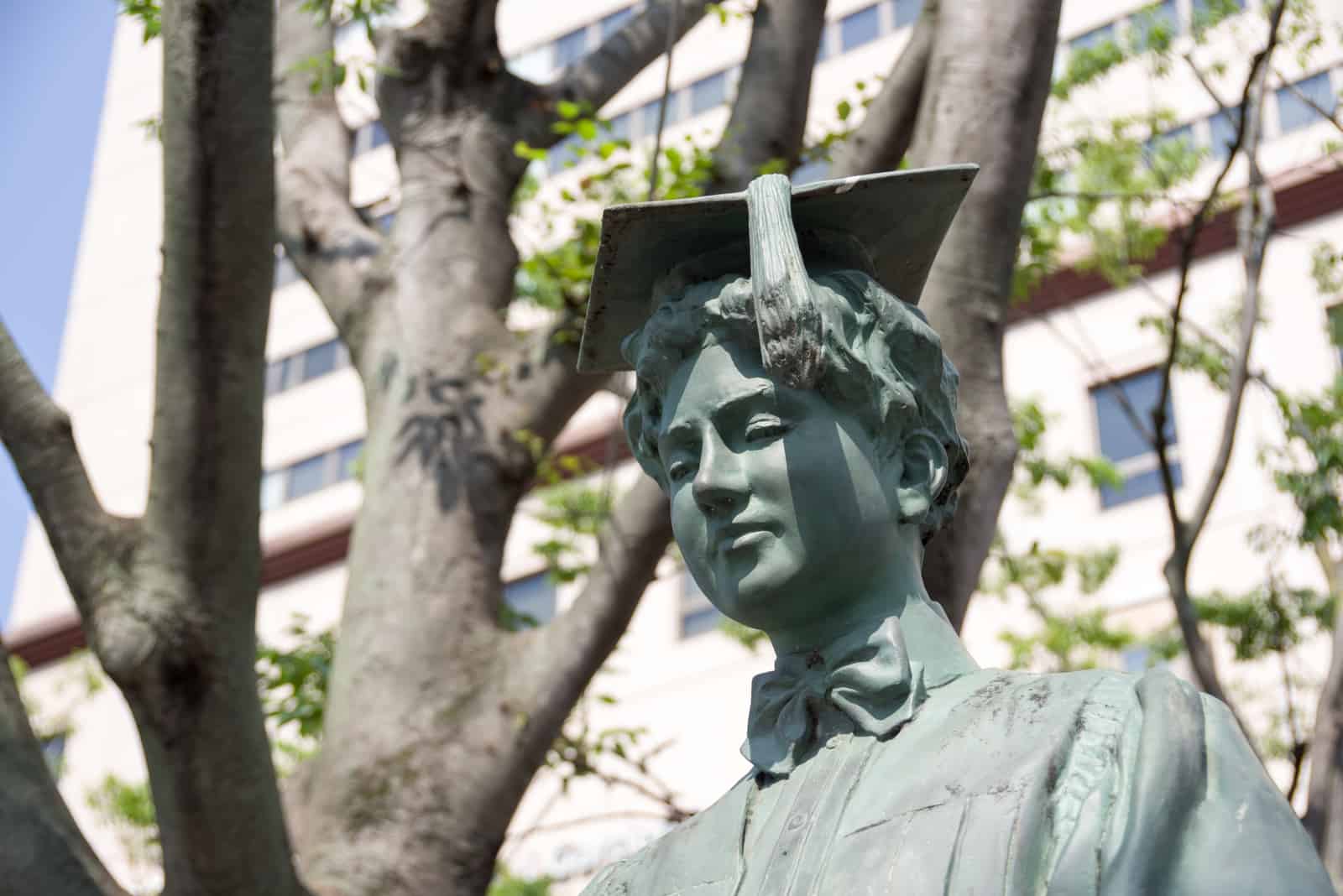
The story of the first Akita in America is one starring Helen Keller, who famously owned purebred Japanese Akita Inu, and thus, introduced the Japanese breed to the U.S.
The names of her two pups were Kamikaze-go, and his brother, Kenzan-go, and she had received them as a gift from the Japanese government because of her contributions to the relationship of the two. Enamored by the breed after hearing Hachiko’s tale, the famous writer quickly fell in love.
The first of Helen Keller’s dogs, Kamikaze, fell ill with canine distemper and died very young, but Kenzan remained her lifelong companion.
She was so fond of the Akita that she called him her angel in fur.
The breed didn’t have time to spread across the U.S. yet because World War II broke out soon after.
Helen’s Akita were both Japanese dogs… the only sort around at the time.
Today, we have two to choose from, and it’s hard to decide.
Maybe we can help you make the right choice?
American Akita Vs. Japanese Akita: Which One Should I Get?
It’s the reason you looked up this term, right?
It’s a matter of preference, really.
Even though both of these breeds are known to be wary of strangers, and are borderline unpredictable around other dogs, it’s very hard to give a straight answer to this question.
If you are an admirer of Japanese culture and history, and want a dog to reflect your passions, you will most certainly prefer the authentic Akita Inu!
However, if you are after a larger, more powerful dog for protection and comfort, then maybe the American Akita is right for you.
Is The American Akita Less Aggressive?
In theory, its German Shepherd and other European ancestries should give the American Akita a breath of stability over its more purebred Japanese cousin.
On the other hand, it is a larger, more dominant dog that looks to be the king of the dog park at all times.
There is no clear rule of thumb to determine which of these breeds is less or more aggressive.
Both are very wild and temperamental breeds of dog, requiring a firm hand and a lot of discipline and socialization.
‘Are You Ready For Any Akita’ Is The Real Question
Akita are dogs to consider carefully because they require a lot of work and understanding to raise them.
They are NOT for everybody.
Many first-time dog owners regret not having researched enough before getting one.
Sure, an Akita puppy might be harmless enough, even if it does gnaw through a slipper here and there, but you’d better put in some elbow grease to raise it properly while it’s young. Otherwise, you might find yourself dumbfounded by this incredibly hard-headed and unpredictable breed.
Is The Akita More Of A Guard Dog Or A Family Pet?
Their prey drive will have them leap at the sight of almost anything, be it a cat or a bird, unless properly trained not to.
Akita Inu don’t get along well with other dogs, and they’re known to be aggressive towards the same gender as them.
They require early socialization, and it’s imperative that they get used to other dogs at an early age.
This Japanese dog is known to distrust strangers, and while this makes it an excellent guard dog breed, it also makes it somewhat unmanageable.
After all, you wouldn’t want it snapping at the poor mailman or something, would you?
Nonetheless, if raised right from a young age, it can be the perfect pet and a delight to all family members.
It is important that you show both firmness and patience with this hardy spitz.
Akita In A House Or An Apartment?
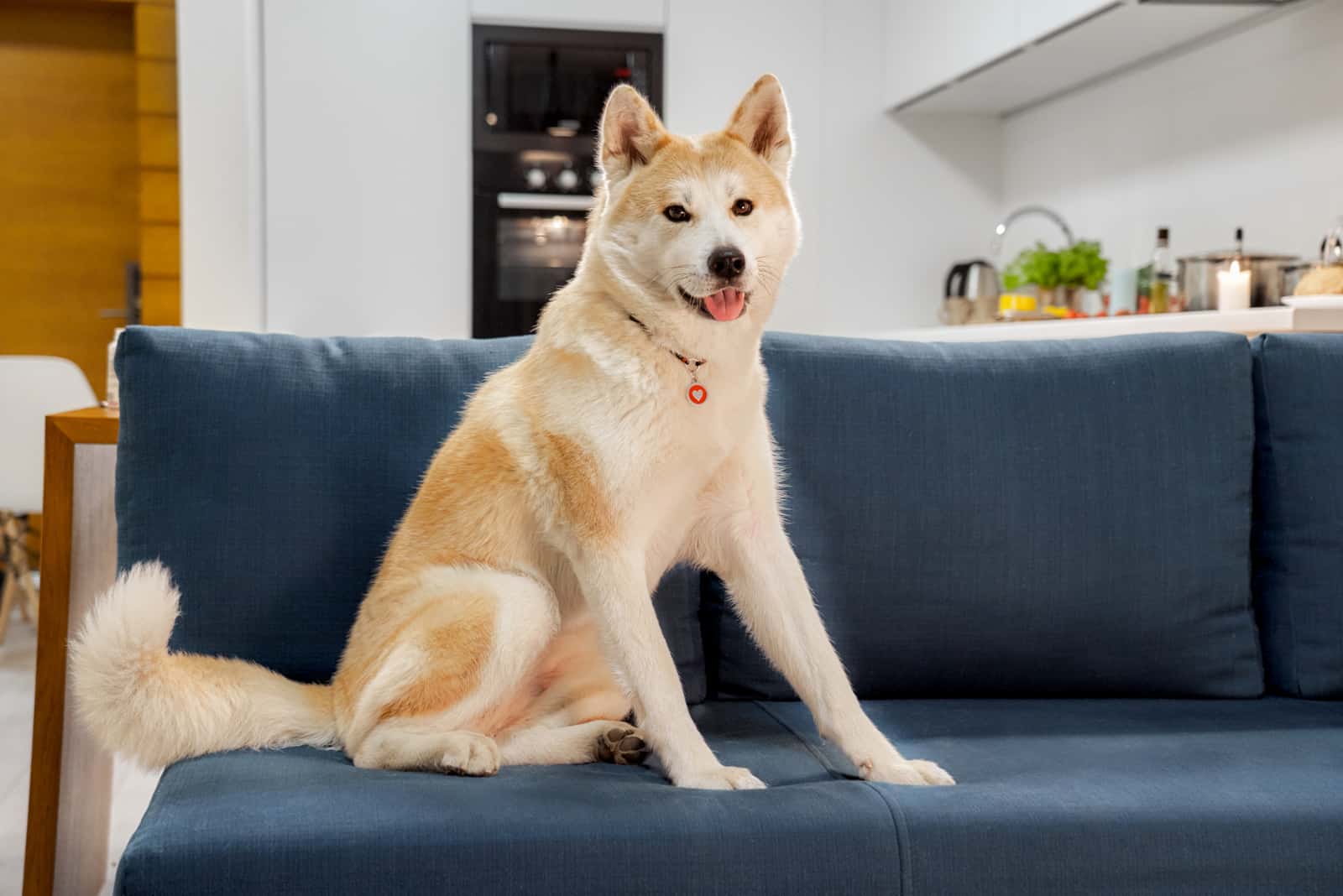
Ideally, you should have a big yard for it to run around in, and be active whenever it feels like it. This breed is very active, and it requires up to 2 hours of exercise each day.
This could prove a task to anyone who doesn’t have one.
This large breed could also prove to be an obstacle, lounging around in the hallways of your condo.
This dog is not well suited for small apartments. Ideally, it needs a large house and a lot of space.
If you live in an apartment building, perhaps you would consider a Shiba Inu instead?
Do Akitas Shed A Lot Of Fur?
Akitas shed a moderate amount of fur, and they should be groomed once a week ideally.
The thick double coat is also the pride of the Akita, so you should take proper care of it and make sure your dog’s hair glistens, especially if you plan to take it to the show ring at an Akita club or a national kennel show at some point.
What’s The Consensus On Akita Food?
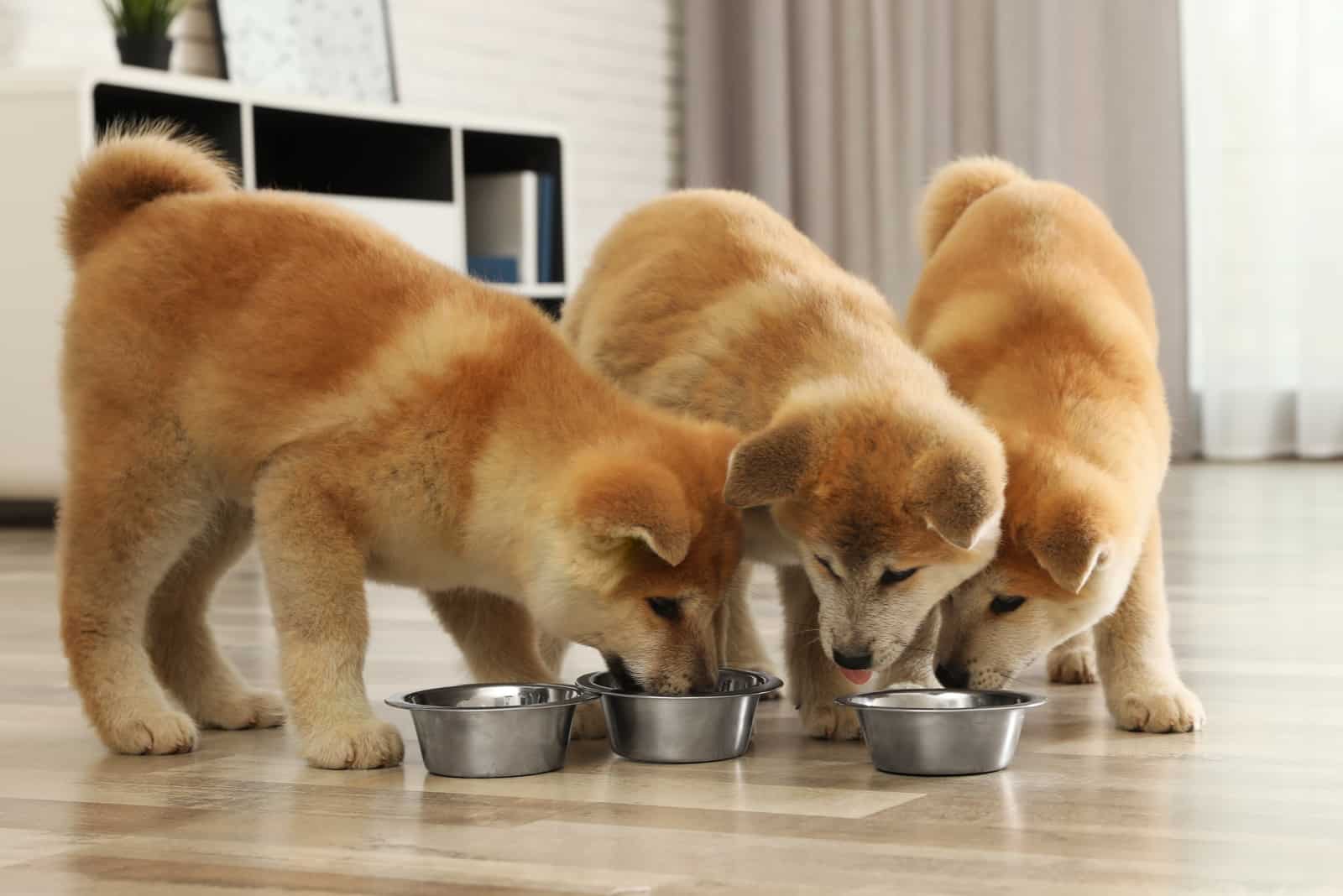
They aren’t really all that different, although the bigger of the breeds is more likely to need more sustenance.
Proper food is imperative for both breeds of the Akita.
Akita puppies should be fed premium puppy food up until the age of 4 months.
These dogs are very sensitive to both pesticides and preservatives, especially the Japanese kind, so you should take great care that the food you buy or prepare for them is free of these substances.
Historically, these dogs ate food that was most available in the Japanese isles, like rice and fish.
Indulge them with a pescatarian treat once in a while!
Rice is a very natural way to ensure your pup’s carbohydrate requirement for the day, but it should be rinsed of bleach and prepared without salt.
You can serve it to your dog, along with either dog food or unseasoned meat.
However, dry food should be the main element on your dog’s menu, and an Akita can eat up to 4 to 5 rations a day!
American Akita vs Japanese Akita: Choosing The Healthier Strain
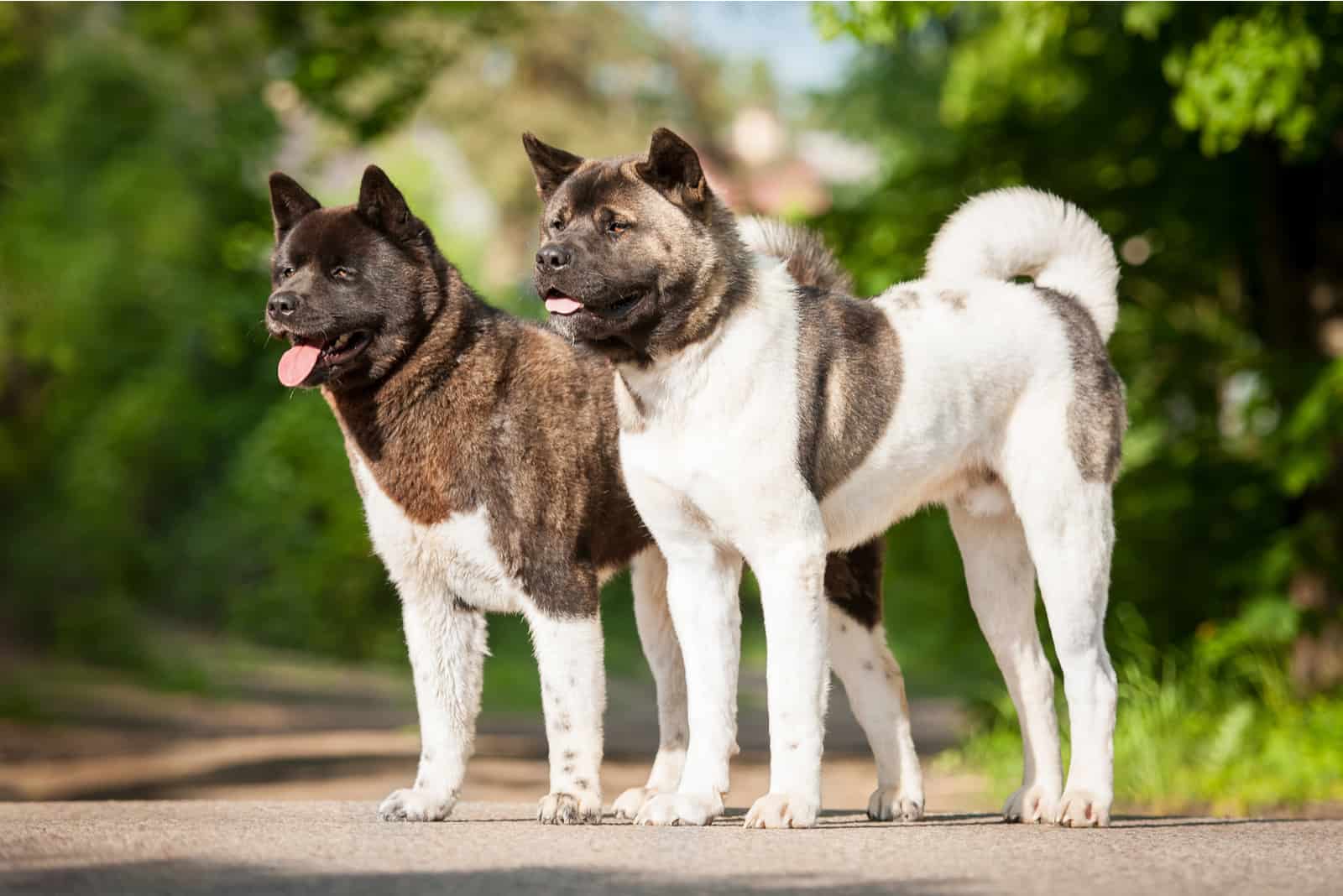
Akita are subject to an array of inherited autoimmune diseases like Vogt–Koyanagi–Harada (quite a mouthful) syndrome, a common hereditary disease affecting the eyes, and causing anemia, lupus, endocrine diseases, and also problems with the adrenal and thyroid glands.
American Akita are the more resilient of the two. Breeders who created this variant of Akita have ensured that the maximum amount of unwanted genes are replaced.
The Japanese, with their limited amount of acceptable and available bloodlines, couldn’t be as liberal.
As they age, Akita become especially susceptible to thyroid deficiency.
Hip dysplasia and elbow dysplasia are very common issues in a lot of large breeds, and Akita Inus are no exception. This also extends to the
American sort as it is a difficult trait to breed out. Because of its large frame, as it ages, a dog’s joints become unable to bear its bulky body.
Glaucoma and other ophthalmic issues are also common with this breed, so mind its eyes, and be sure to give your dog lots of vitamin A!
Another health issue that is common for all dog breeds is the dreaded bloat.
Gastric torsion, also known as ‘bloat’, is a condition where the dog’s stomach fills up with air and starts to fail. It is life threatening, and should be seen as an emergency.
Akita Inus are also very sensitive to vaccines, drugs, insecticides, anesthetics, and tranquilizers, so be mindful when taking them to the veterinarian for a shot or for worm pills.
Your licensed veterinary practitioner will likely know how to approach any issue regarding your Akita.
American vs. Japanese Akita: Is There A Winner?
There is nothing I could say that would be impartial enough.
This dilemma is truly in the eye of the beholder!
They are equally wonderful and loving lifelong partners, and they are the very symbol of loyalty.
In the eyes of many, they are the embodiment of everything they love in dogs, and then some!
Even cat lovers will find something to adore in this very neat, independent, and proud breed.
You should keep in mind that this breed of dog often makes for a less-than-ideal family pet, but that is not to say that you can’t make it one.
If you are a first-time dog owner, maybe you should consider a training program or a dog school for your pooch.
We leave the choice up to you because it’s not an easy one for us.
This amazing breed is as astounding as they come, no matter the shape or size.
Read Next:
• 11 Best Akita Breeders In The UK That You Need To Know About
• Japanese Spitz Vs. Samoyed – Which Is The Best Dog For You?
• Miniature Akita: Everything You Always Wanted To Know
